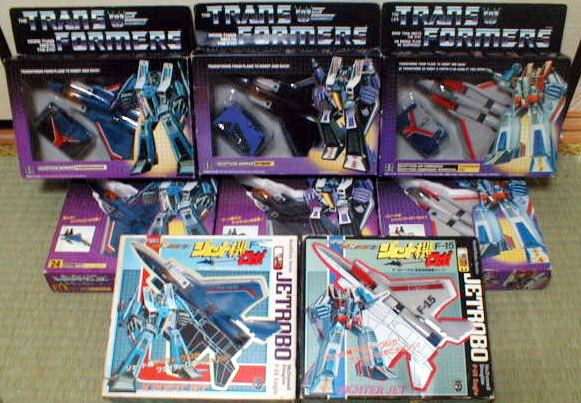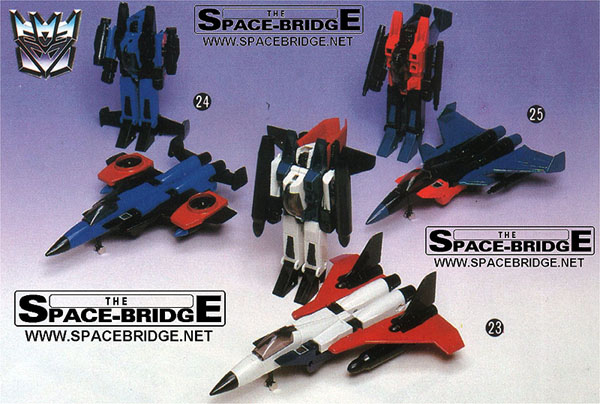The Decepticon jets have always been an immensely popular and well-loved sub-group of G1 Transformers. They have spawned many many different incarnations of themselves in almost every subsequent Transformers toy range since G1. Starscream, Skywarp, Thundercracker, Thrust, Dirge and Ramjet are unforgettable staples of the original G1 mythos and are some of the most instantly-recogniseable and well-known Transformers ever to see release globally. Every time a new reissue repaint of the jets is done by Takara/E-Hobby, it instantly becomes an immensely desireable collectible and rockets in price over subsequent years. Sunstorm and Ghost Starscream are excellent examples of this. However, as recogniseable as they are, those original six jets had gone through many revisions and alterations before they became the characters and toys we grew up with and adored. The legacy of some of those changes and evolutions is still in evidence today through the existence of very rare variants (packaging, moulding, paperwork, prototypes etc), and these special pieces provide valuable insight into what could have been for those famous Decepticon jets.
This article will first of all focus on the very earliest G1 Transformers releases from the start of the line in 1984. A few of the jets shown here were probably amongst the absolute first Transformers on the shelf back in 1984 in the US. Not only are they pre-rubsign, but very early pre-rubsign. There are packaging and moulding variations to prove this. After that, the article will focus on a period just before the release of the second series of Transformers in late 1984/early 1985, a period when toys such as Ramjet, Thrust and Dirge were in transition from concepts and prototypes to actual production items. There are some really staggering things to note from this time, and they will be covered later. While there are some very valuable things that could be covered related to pre-release Diaclone mock-ups of the jets, this article will focus mostly on the Transformers era.
PART 1 : THE EARLY PRE-RUBSIGN SERIES 1 RELEASES
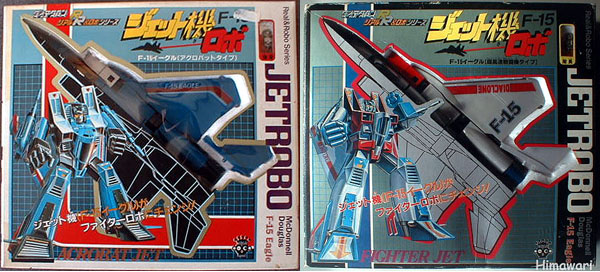
The very first Transformers Decepticon jets were of course heavily based on the Japanese Takara Diaclone F-15 Jetrobo releases in Japan, from the Diaclone Real & Robo series. The F-15 Acrobat became Thundercracker in the Transformers line, and the F-15 High-Speed Fighter became Starscream. These Diaclone jets were released in Japan in March 1983. Being Japanese pre-Transformers releases, these toys were not as safety-oriented as the later Transformers releases in the UK and the US. The missile launchers fired potently and the toys contained relatively sharp and pointy sections on their wings as well as solid plastic nosecones.
That brings us nicely on to the first item of interest in this article, a US Transformers Thundercracker from 1984:
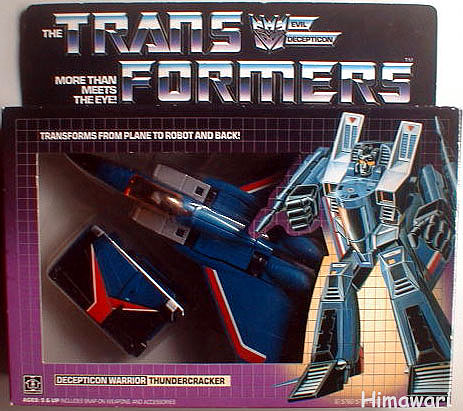
At first glance, there may not be anything noticeable to you about this sealed-on-backing-card original Thundercracker that would be considered out-of-the-ordinary. Upon closer inspection, however, certain things start to become apparent. First of all, it is clearly a pre-rubsign release Thundercracker, so definitely 1984. Much more interestingly, have a close look at where the character artwork for Thundercracker meets the cellophane window where the toy inside is being displayed. The thin section of box between the art and the window displays the same grid pattern that is in evidence all over the box front of this Thundercracker and pretty much all G1 Transformers boxes of the time. That's not strange, is it?
Actually, that is very abnormal indeed. An absolutely huge majority of G1 boxes from the earlier years actually do NOT have that grid pattern in evidence between the art and the window. In fact, they just have that thin section there coloured solid grey. Here are a few regular G1 boxes to compare with:
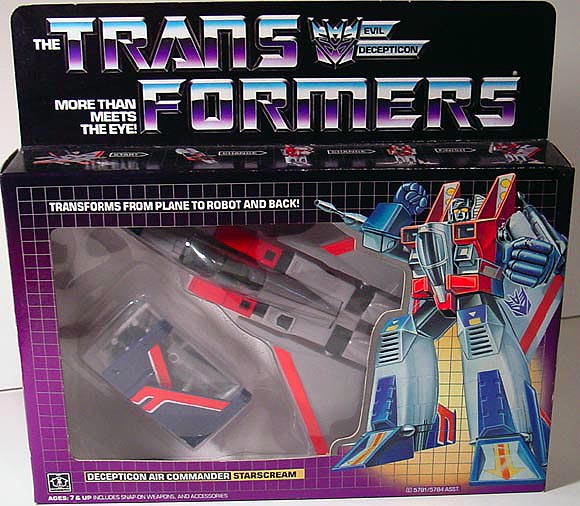
Over the years I have been able to save what few pictures I have found on auction sites of early pre-rub G1 boxes where the grey section is missing and the grid pattern remains. Here are the same three G1 boxes as above (Starscream, Sunstreaker and Mirage), but the early pre-rub versions, just like the Thundercracker:
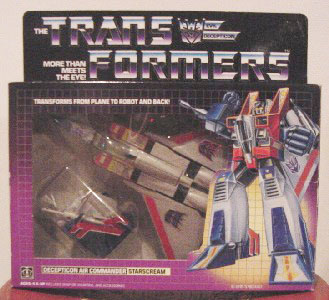
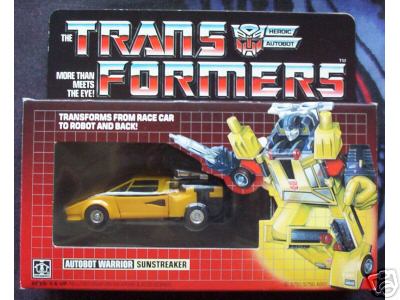
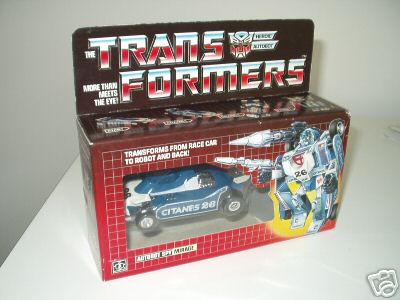
Curt noticed something very interesting with the 'no grey' early boxes, especially concerning the Autobot cars. He noticed that the cut-away section was slightly larger on the earlier boxes and as a result you could sometimes see the end of the cardboard insert and accessory baggie through the cellophane window. This is most noticeable with the Sunstreaker boxes, and maybe it was as a result of this that Hasbro altered the packaging. See below:
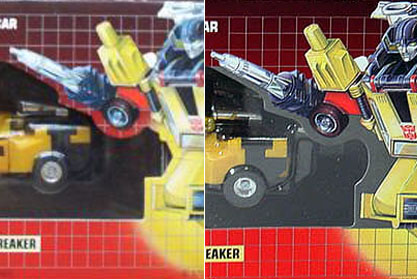
The section that exposed the end of the insert was no longer exposed for the later box with the grey section. In addition to that, some may say that the grey section allows the character art to stand out more, especially on the Decepticon boxes which are darker with typically darker-coloured character art for the early releases.
Aside from the packaging, in Thundercracker's case (and probably Starscream's), there are actually features on the toy as well that make it quite standout when compared to other jets released later. Here are some close-ups of that early pre-rub Thundercracker sealed inside its bubble:
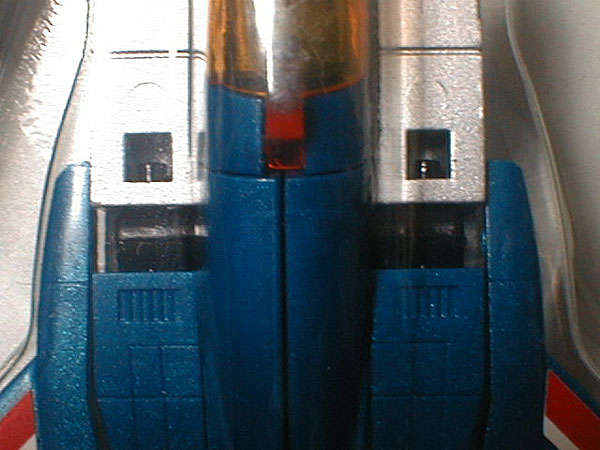
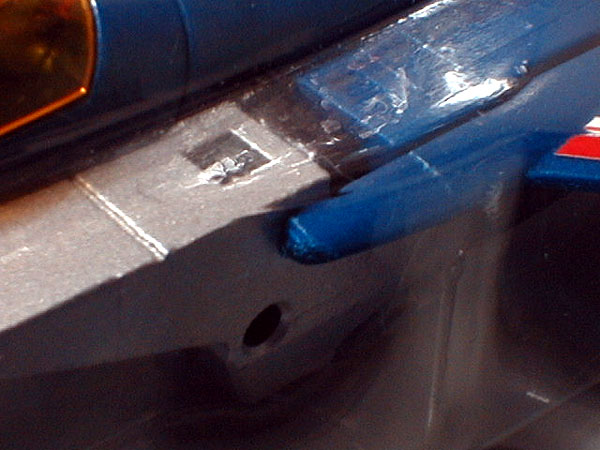
Notice anything about the tip of the wings?
Keep in mind that this is probably one of the absolute first production Thundercrackers to be released under the Transformers banner, the first version of this mould since the Japanese Diaclone. The chances are that this, and any other early pre-rub TF in the packaging with no grey section, will have plenty in common mould-wise with its Diaclone predecessor. Early pre-rub Thundecracker is no exception. Here is a Diaclone Thundercracker F-15 wing alongside a normal Transformers Thundercracker wing:
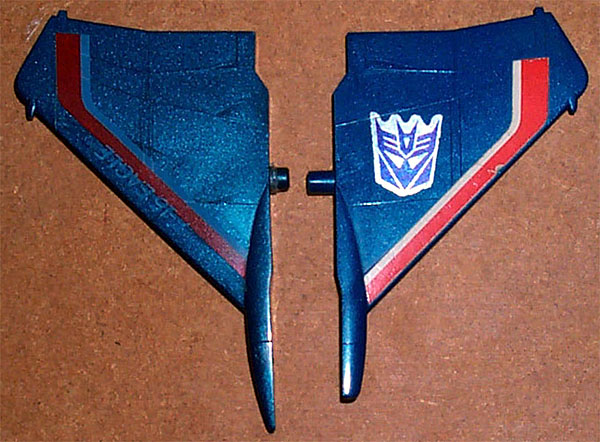
The Diaclone wing (left) is significantly longer. It has a quite sharp and pointy tip to it compared to the shorter, rounded-off Transformers Thundercracker wing (right). The connecting peg on the Diaclone wing is also shorter.
How does this tie in with the early pre-rub Thundercracker in the strange G1 packaging? To answer that, we need another early pre-rub G1 Thundercracker, but this time it's a loose one:
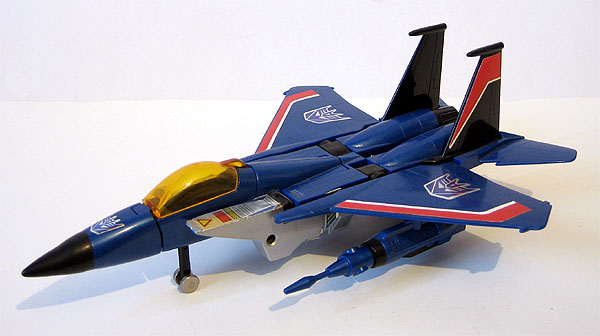
This loose Thundercracker is exactly the same as the one pictured in the sealed bubble in the strange 'no-grey' early packaging. In the thumbnails it has been compared with a regular rubsign Thundercracker. The orange canopy on the early Thundercracker is totally smooth with no ridges and there is no rubsign, that marks it out as a pre-rub Thundercracker. Nothing special there. Now, I've already directed your attention to the wings of the sealed early pre-rub Thundercracker, and shown you how much longer the original Japanese Diaclone's wings were.
Here's the money shot:
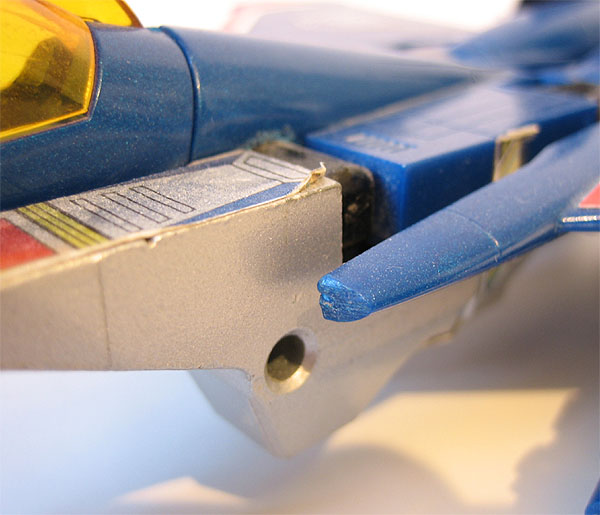
The long tips of the early pre-rub Thundercracker's wings have actually been physically SANDED down! No smooth moulding here, these were definitely altered after moulding. Just running your finger over the tip will confirm how uneven, rough and abrasive the surface of that tip section is. Both wings are sanded on this Thundercracker, and if it weren't for the sealed one shown at the start of this article exhibiting exactly the same sanded down wings, I would have thought the owner of this toy mutilated it themselves. Here's a closer look, with comparisons to a normally moulded short TF Thundercracker wing:
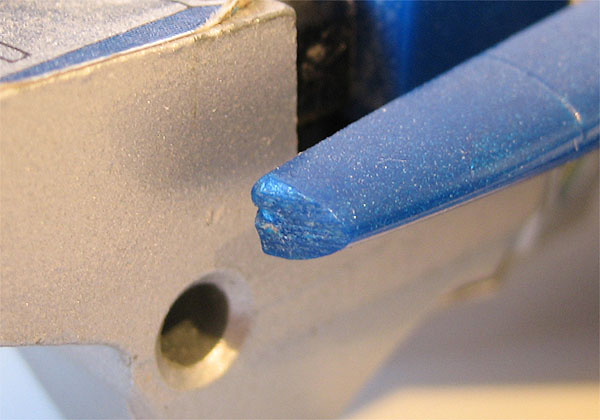
The first thumbnail shows a close-up of a normally-moulded Thundercracker wing, and the other two thumbnails show a comparison between the sanded wing of the early pre-rub alongside the normal wing.
The reason this would have happened is that Hasbro would have wanted to round off the sharp and pointy section of the main wing due to child safety concerns. It appears that in order to get the first batch of 1984 Transformers out early enough, there wasn't sufficient time to re-tool the F-15 mould to accomodate newly-planned saftey measures. As a result, these super-early G1 jets would have had to have their pointy wings sanded down until the next batch were ready with correctly moulded parts. The plastic insert bubble for the jets even leaves space for the extra-pointy wing mould of the Diaclone. The production run for these very early jets is probably very very low, which is why 1984 G1 Transformers in those early 'no-grey' boxes are so extremely rare and difficult to find. Some collectors may never have even seen those boxes before.
This particular Thundercracker came to me in a lot of other Transformers from the same period, all of which were early pre-rub versions showing some strange variation from the more common pre-rub or rubsign-era moulds and releases. In the case of Thundercracker, the wings were not the only Diaclone-esque feature carried over:
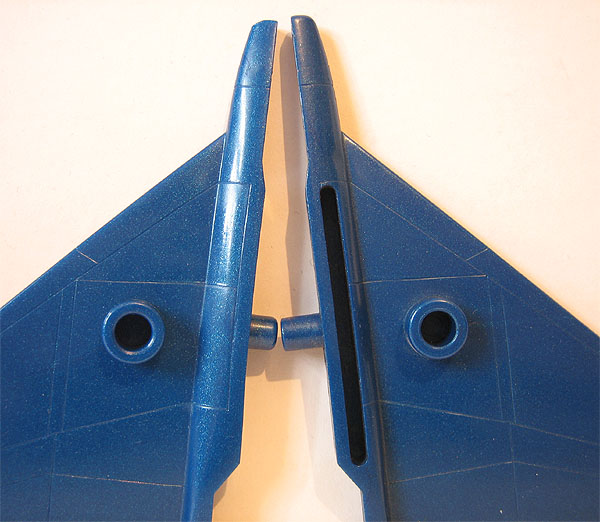
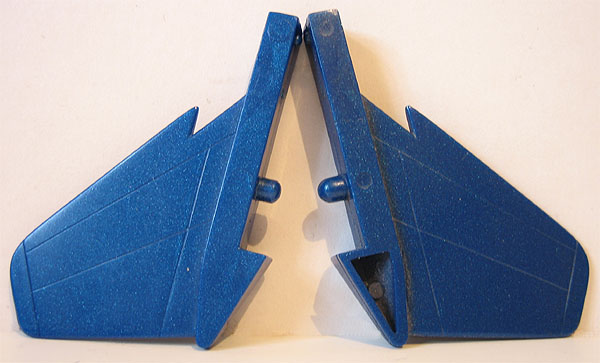
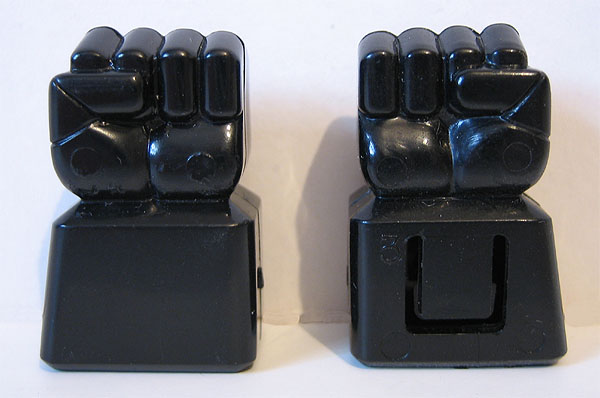
The early pre-rub Thundercracker parts are on the left in all the above pictures. The big main wing is solid underneath with a small connecting peg, but the regular Transformers rubsign-era wing has a long cavity running vertically down the side and a longer connecting peg. The early pre-rub rudder is solid underneath with short peg, and again the regular rubsign rudder has a hollow cavity with a longer peg. The early pre-rub fist is solid on the inside, the rubsign fist has a "U" shape on the inside. All the aforementioned moulding features on the early pre-rub Thundercracker parts are shared with the Diaclone mould.
However, most of the above features can be found on almost all pre-rubsign Thundercrackers. There is one other feature of the early pre-rub Thundercracker that truly stands out and is unique, and that is the complete and utter lack of a copyright stamping anywhere on the toy. This is where the copyright should be:
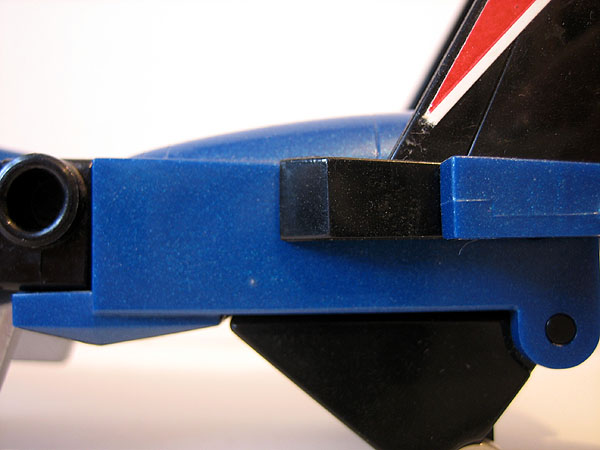
Nothing at all. Why is this significant? Because only the Japanese Diaclone is also devoid of a copyright stamping. Every other official version of Thundercracker ever released throughout the world has a copyright, be it Italian Diaclone, Mexican Transformer, rubsign US Transformer, Reissue, Japanese Transformer, Milton Bradley European Transformer, anything. They ALL had copyrights. Here is the rubsign Thundercracker's copyright:
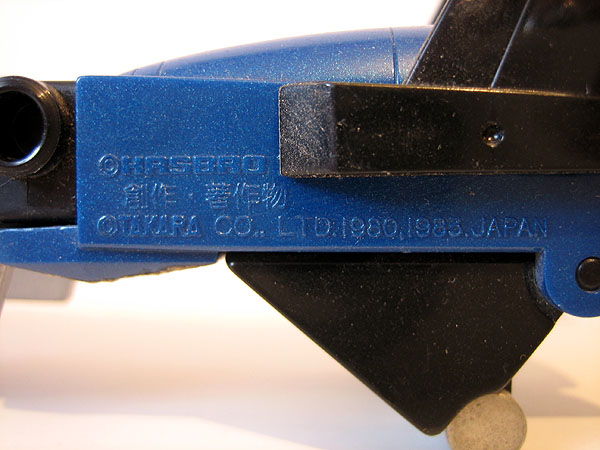
This proves that the early pre-rub Thundercracker is so early that it has probably been made straight out of the original Japanese Diaclone mould. The only differences with the Diaclone being that the nosecone is rubber instead of hard plastic, the missile launchers were neutered and the pointy wings were manually sanded down as a temporary solution until a mould re-tool was carried out very early on in 1984 for all subsequent TF Thundercrackers. Even the colour of this early pre-rub is close to the sparkly blue of the Diaclone with a tiny hint of green. A truly significant and revealing piece of Transformers history, not to mention one of the absolute first!
PART 2 : THE SERIES 2 CONCEPTS AND PROTOTYPES
So the Thundercracker was an example of a truly early release, almost a stop-gap measure. There are however jets that never quite made it to the stage where they saw official release in packaging. Here is a picture from a Takara trade catalog (also used elsewhere subsequently) depicting some of the proposed second series figures of Transformers for release in 1985:
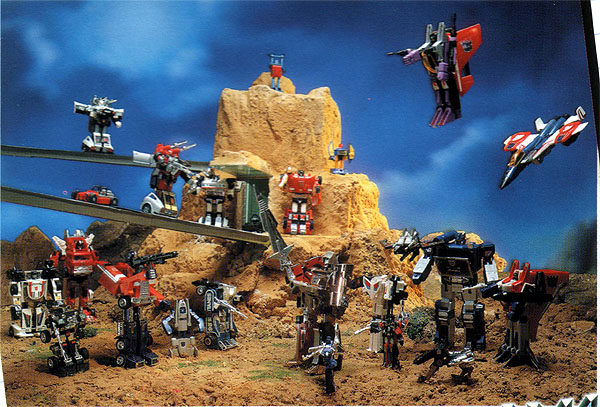
There are many things of interest in this early Takara picture. Notice the use of White Astrotrain, which would have been common in very late 84/early 85 Takara literature. The white Powerglide and blue Cosmos were of course 'reissued' as E-Hobby minibot recolours, but the blue/red Seaspray and red Beachcomber have not been re-done, so remain prototypes featured in this picture. The Bluestreak in the picture appears to be the blackhooded Diaclone-style version. Megatron is also shown with his Japanese-release-only sword and late Microchange-style chrome-with-red-legs look (a scheme that was never used for the Japanese Transformers Megatron, but used in the US). But of course, this article is jet-related, so of special interest to us are the three Decepticon jets which appear to be very early renditions of Thrust, Dirge and Ramjet. At first glance it appears that it's just a case of the series 1 jets (Starscream, Skywarp and Thundercracker) being shown with the series 2 jet wings. Closer inspection shows this rudimentary assesment to be incorrect.
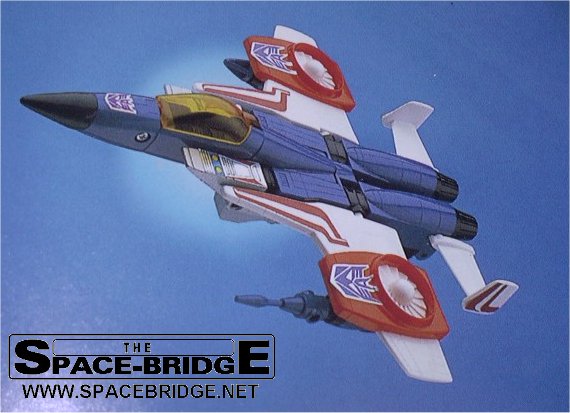
This appears to be a pre-rubsign mould (smooth canopy) Thundercracker body, launcher and missiles, with Thrust wings and fins. The Thrust parts as you will no doubt have noticed, are white and maroon, not black and maroon! So, not quite as simple as it first appeared. Now this is where things become seriously interesting, because this odd hybrid was taken one step further and artwork was produced for him:
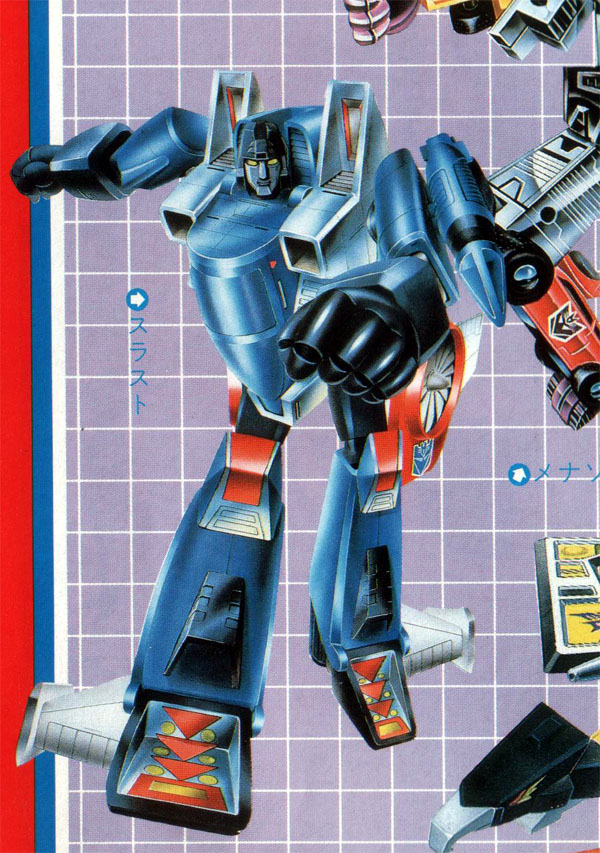
This spectacular image is taken from a poster contained within an issue of Japanese Television Magazine. This artwork was also featured in the small Japanese Encyclopedia guide to the Transformers in Japan. You can see very clearly it is a Thundercracker-bodied Decepticon jet with white (or silver) and maroon Thrust parts just as in the Takara catalog picture above. His canopy is now clear instead of orange. Interestingly enough, his name is written next to him as "Thrust". Notice the Menasor and Buzzsaw(!!) artwork around this "Thrust". The character above has art for what would be production Thrust's stickers, as does the catalog toy.
Here's "Dirge":
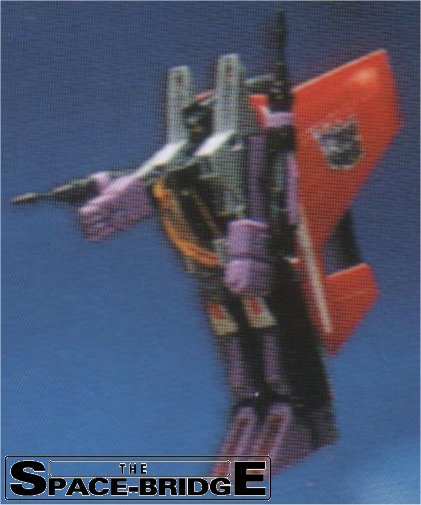
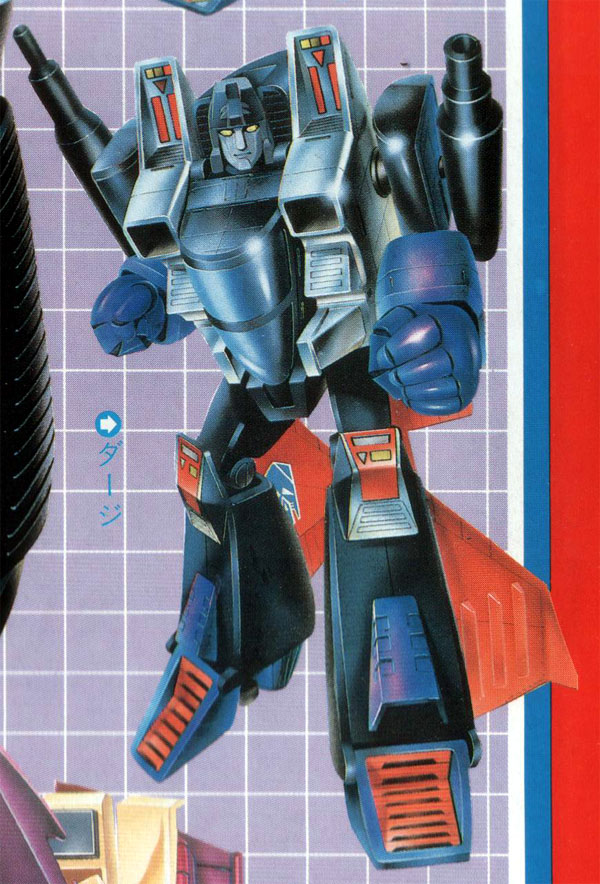
Not only does this Skywarp body have Dirge's wings, but they're RED Dirge wings, catalog pic and art! Similar to "Thrust" above, this artwork is labelled as "Dirge" and the canopy on the character art is clear whereas the toy pictured has Skywarp's orange canopy. The ridged canopies on these guys suggest that this concept was being aired at a time when the mould changes for 1985 for the jet canopies were already underway. It should also be noted that the art for what would be the stickers on this toy are those of production Dirge as are those of the catalog toy. But the weapons he is carrying in the artwork are correct Dirge weapons, unlike in the catalog picture before it.
Here's "Ramjet" :
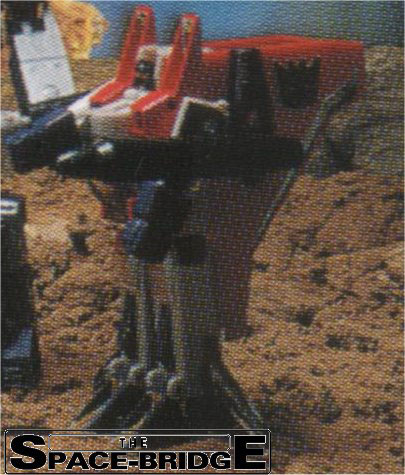

Labelled "Ramjet", this Starscream-bodied figure has Ramjet's wings, fins and bombs in both the catalog picture and the artwork above. The artwork also depicts Ramjet's production stickers, not Starscream's. Canopy is again ridged as 1985 toys were, not 1984.
So it's a real case of halfway-house hybridisation. The catalog toys are 1984 series 1 jet bodies (series 1 canopies) with mostly strangely-coloured series 2 jet wings. "Thrust" and "Dirge" have series 1 weapons, only "Ramjet" has correct series 2 weapons. As for the artwork, we have series 2 mould bodies in series 1 colours (series 2 canopies) again with the mostly strange-coloured series 2 wings. "Thrust" still has series 1 weapons, "Dirge" has series 2 correct weapons and "Ramjet" retains his correct series 2 weapons. All have correct series 2 production stickers.
Amidst all that confusion, what comes to the surface via the catalog is that the wing moulds and stickersheets appear to have been updated first, then by the time the artwork was done the weapons and moulding of the actual jet bodies were updated (specifically the now-ridged jet canopies, as well as their colour). At this point, the final body colours, fist colours and wing colours of what we have always known as production Dirge, Thrust and Ramjet had not been finalised, changed or updated.
Shifting over to the US quickly, here is a scan from a recently discovered "Transformers 1985 Product Listing" sheet dated September 1984:
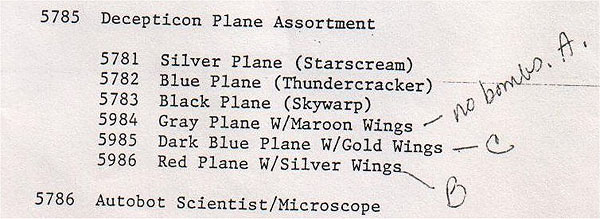
"5984" is Ramjet, yet he is listed as a grey (Starscream-bodied?) jet, "5985" is Dirge but he supposedly has "Gold Wings", the importance of which I will cover very shortly, but the best thing here is "5986 Red Plane W/Silver Wings" and that is supposed to be Thrust. Now what colour are the hybrid Takara Thrust's wings in the above catalog and artwork? Silver/white! So that concept was obviously still floating around towards the end of 1984 even in the US.
Now you think THAT was weird? Have a look at this!!
This unbelievable image comes from supremely early 1985 Takara photography from the collection of Paul Hitchens. Click on the above for a larger image to see the spectacular hand-painted BLUE Dirge wings! Are those larger vertical fins on the wing as well? The fact that he comes with Starscream's red diecast, blue feet, nosecone and shins and Skywarp's body takes the idea of a hybrid to an even stranger place! Here's a bigger image of "Dirge":
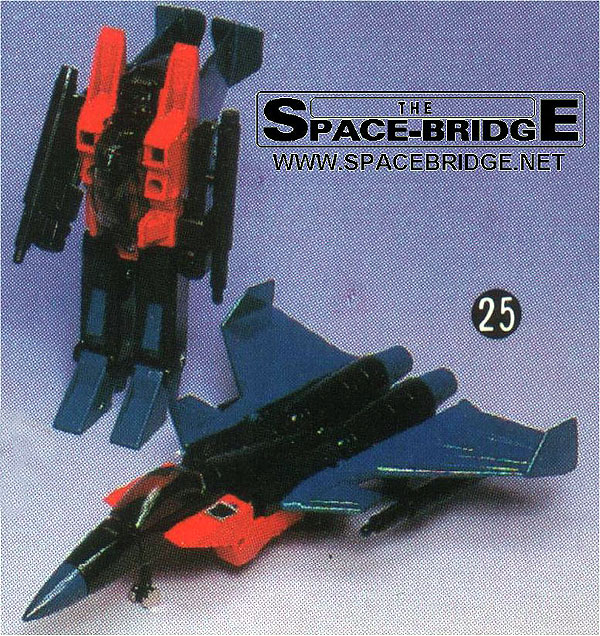
And what about the Dirge-coloured "Thrust" with blue series-1 missiles and correctly coloured Thrust wings? Ramjet appears to be mostly correct although as with all the others in this picture, his rubsign is on his diecast section and there are no factory stickers. Also, it appears that the chest-section of his diecast is dark blue. Is this photography earlier than the hybrid images above? It probably is, but it's hard to tell from the jets alone. The other things featured alongside the jets in this literature give more clues to that end, but now isn't the time to elaborate! The significance of those strangely-placed rubsigns will also be touched on again later in this article...
Time to just take a little step backwards chronologically to a period before even the above Takara catalogs or artwork were seen and before any incarnations of Ramjet, Thrust and Dirge ever appeared in any sort of official or public literature. This would be a time when Hasbro/Takara would be prototyping concepts for the second set of Decepticon jets. Any moulding would be at the hardcopy resin stage, parts would have been hand-painted (if at all) and assembled a while before the final colour-moulded plastic production pieces were ready to be featured in catalogs or on released toys.
What you are about to see is probably one of the most substantial prototype/pre-production finds of the decade related to this area of Transformers. Here are the original hardcopy resin prototype wings for the new jets that would become Thrust, Dirge and Ramjet.
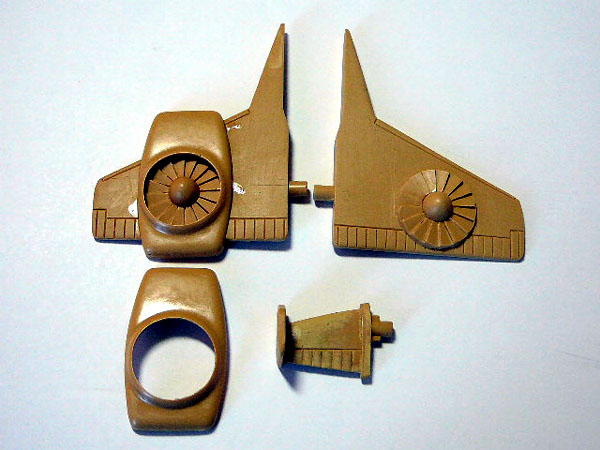
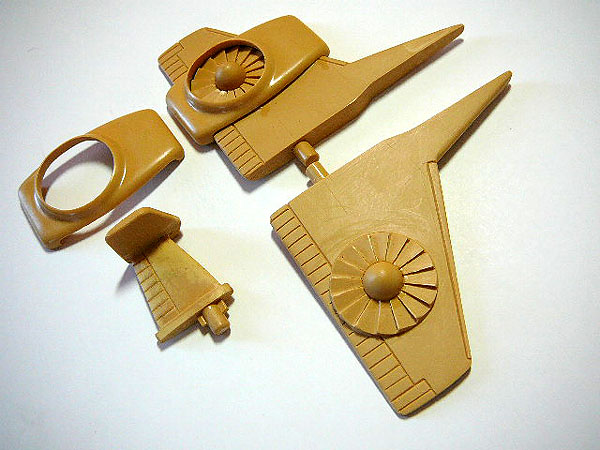
These stunning images of unpainted resin hardcopy prototype Thrust wings were seen very recently for the first time by most collectors. They were previously in the possession of an ex-Hasbro employee and came from the same source as the above 1985 product assortment sheets. A hardcopy prototype is typically one of the very first physical representations of a toy or mould, in this case the main feature of a new character that would distinguish it from the previous three jets. By the time something like these Thurst wings would reach production, mould changes would almost certainly have taken place. The following pictures highlight some of these mould changes:
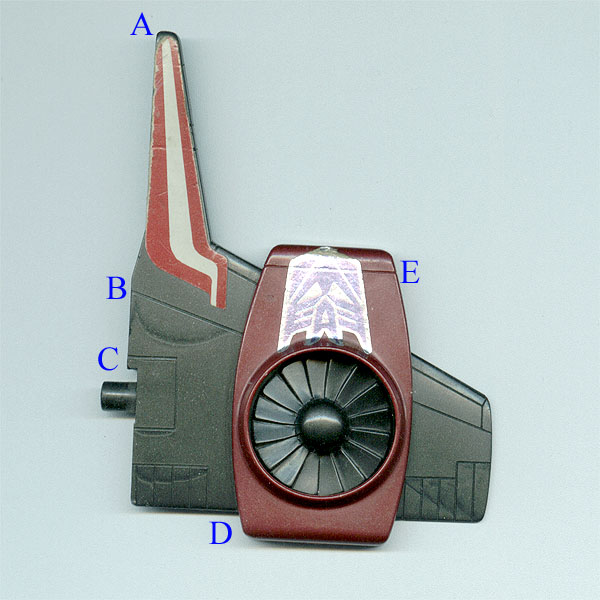
A - The tip of the production Thrust wing is much more rounded than the hardcopy prototype's, most likely done for safety reasons as with the Thundercracker's wings.
B - You can see that an indented diagonal line starts at B and runs across the span of the wing, but the hardcopy does not have that mould feature sculpted into it yet. There is a small vertical line at the right end of the wing as well not featured on the hardcopy
C - Where the connecting peg is located on the production wing, there is a cut-away section and a rectangular moulding line indented on the wing itself. The hardcopy does not have that cut-away section or the moulding lines sculpted in yet.
D - The hardcopy wings has the flap-like moulding lines sculpted all the way along the bottom of the wing, but the production Thrust wing does not have them all the way across the span, they stop just before the fan section and start again just afterwards.
E - On the maroon section, again there is a horizontal line moulded into this section that hadn't yet been sculpted into the hardcopy wing.
There are a few smaller lines sculpted into the production wing under the factory stripe stickers that are also missing on the hardcopy, but you get the idea. One other thing I noticed was that on the hardcopy wings, the fan section appears to have the individual segments of the fan running/overlapping in a clockwise fashion, but the production wing fan appears to overlap in an anti-clockwise fashion. The smaller rear fin also shows a slight variation: On the production Thrust fin, the connecting peg starts higher up but on the hardcopy it's a little further down that side of the fin mould.
In addition to the Thrust hardcopy wings, a set of unpainted Dirge wings + missiles were found as well as a set of hand-painted prototype Dirge wings:
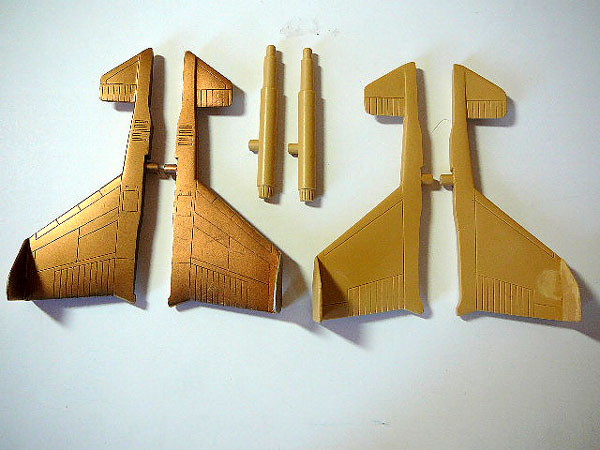
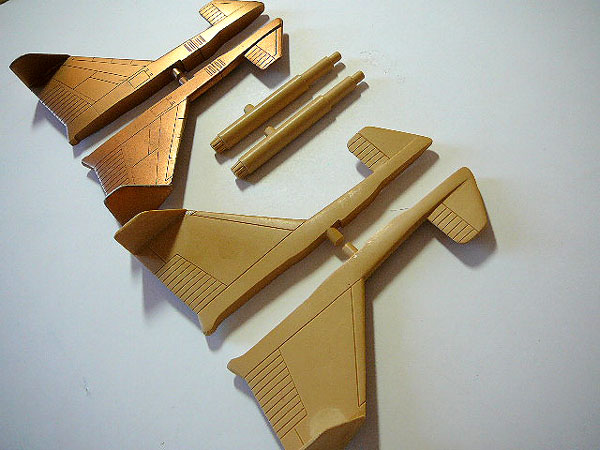
Just looking at the two sets of Dirge wings above shows some differences between the unpainted and painted hardcopy resin wings. The unpainted set have many fewer lines sculpted onto the wings themselves than the painted set which is consistent with an earlier unpainted representation, much simpler. What is strange is that the individual unpainted wings appear to be a one-piece mould but the hand-painted wings appear to be from a 2-piece master mould. Now both of the above sets of wings are vastly different from production Dirge wings, but more on that later.
Unpainted and hand-painted sets of resin hardcopy Ramjet wings also appeared with the above lot:
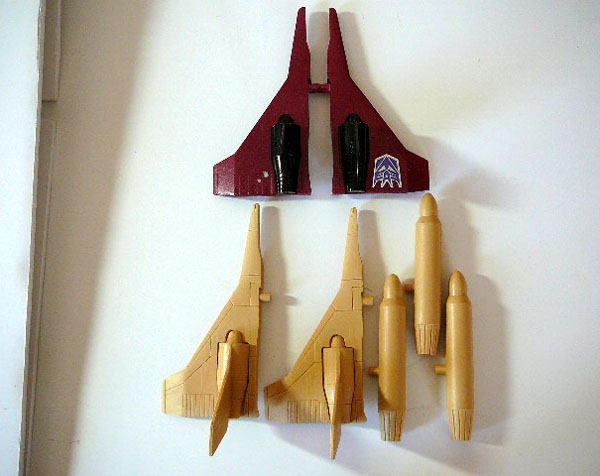
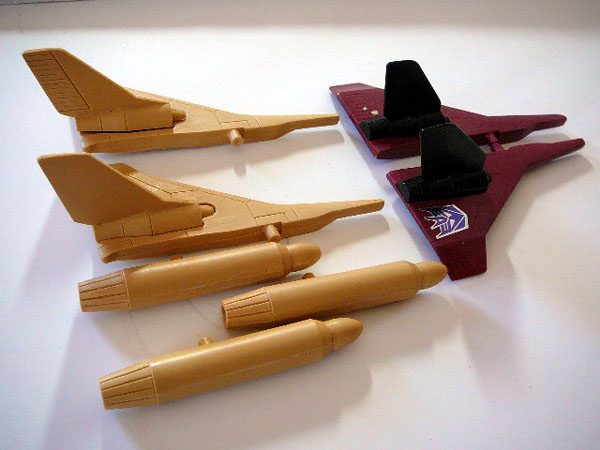
The unpainted Ramjet wings are again missing a few sculpting features on the wings themselves like the set of circles towards the tip of the wings that are on production Ramjet wings. Also, they are longer than production Ramjet wings (highlighted later). Probably the most interesting thing to note on these unpainted hardcopy Ramjet wings is that the rear fin and engine are a one-piece assembly. On the production toy, the fin can separate from the engine. Also just look at how far the hardcopy unpainted fins are swept back compared to the painted set alongside them, so very different. Absolutely amazing.
Having seen the unpainted sets, pretty much the first physical representation of these new moulds (the bodies didn't need re-prototyping), we're going to look at a set of hand-painted resin hardcopy Dirge wings in more detail, followed by a hand-painted set of hardcopy Ramjet wings in similar detail.
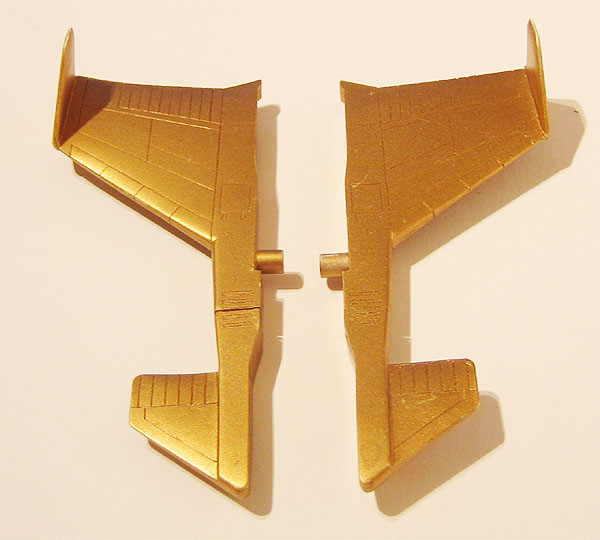
The pictures above show very clearly where the top section of each wing has been glued to the larger bottom section. You may also have noticed that the colour of these wings is neither red (as the Takara art and catalog show) nor is it the dull brown of production Dirge wings. These are in fact hand-painted in a very fetching gold colour. They are also considerably longer than production Dirge wings. How much longer? See for yourself...
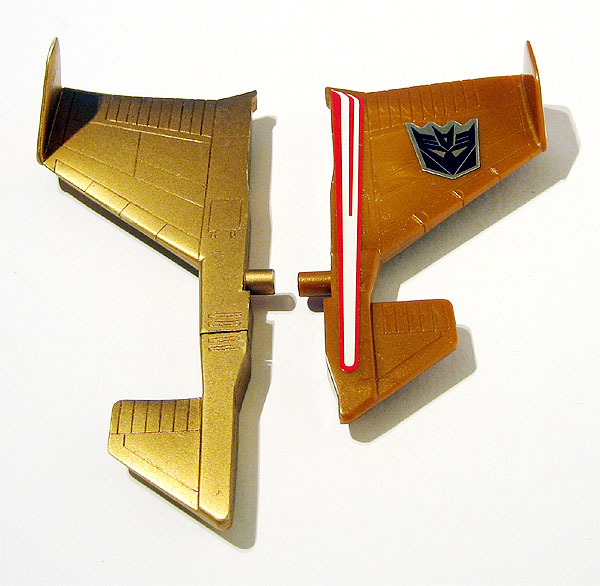
How different?! The extra length of the hardcopy set is quite astounding, and the difference in colour is very obvious. There's only so much you can glean from pictures of wings alone, it's when you actually place the hardcopy wings on a Dirge body that the difference is driven home and you see how different Dirge would have looked. First of all, here is what a production reissue Dirge looks like with the shorter dull brown production wings:
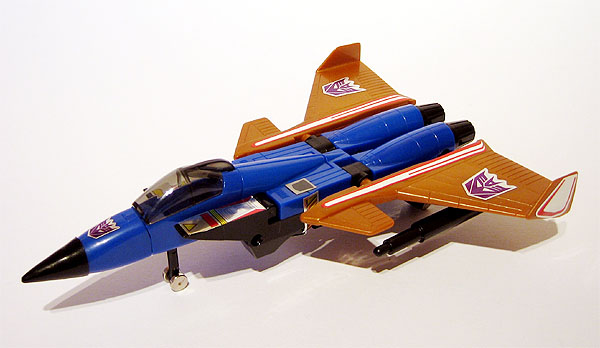
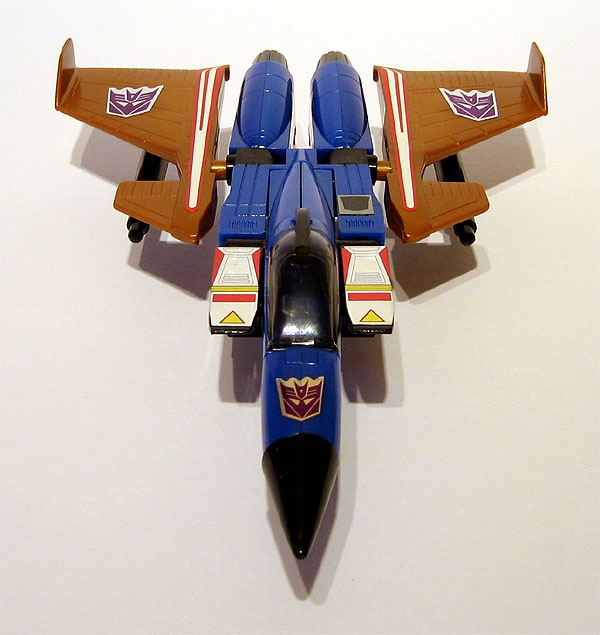
And here's the Dirge body with one of the production wings replaced with one of the hand-painted hardcopy wings:
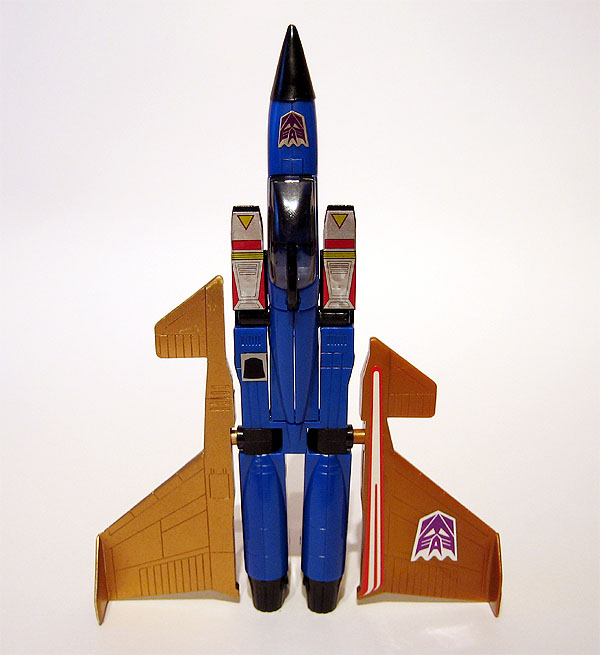
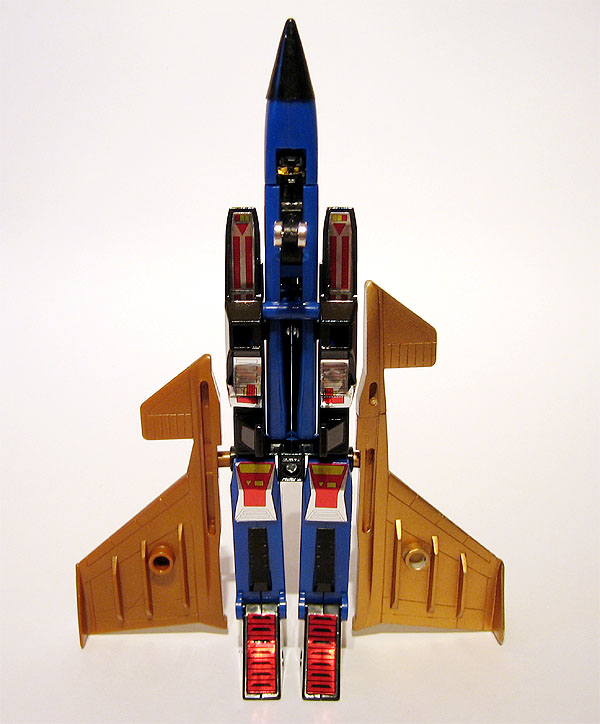
You can see how much further up the jet body the prototype wings extend. It even appears that the hardcopy wing has a greater wingspan. Maybe it's just the novelty value of these recently-surfaced prototype wings, but I think the gold suits Dirge much better than the production wings. To see how good Dirge looks with the prototype wings, both must be attached for the full effect:
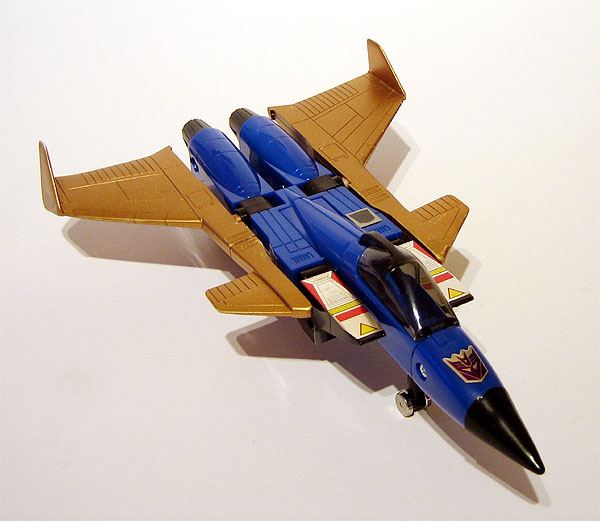
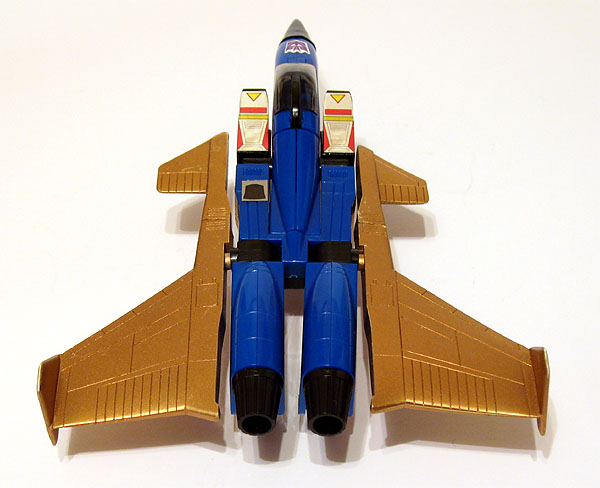
The extra length of these hardcopy wings gives Dirge a more slender appearance in jet mode, the gold contrasting beautifully with the blue of the main body. These wings hold on to the main body of the jet quite well and the fittings are not too loose. The larger vertical fins on the ends of the wings are also slightly more attractive than the full production combination. It was an extremely strange yet exciting sight to see such a well-established, common and recogniseable Transformer look so different whilst knowing that this is very easily how it could have turned out.
Here are a few close-ups of the standout features of the hardcopy wings, especially the slightly misaligned fitting between the two parts of the prototype wing:
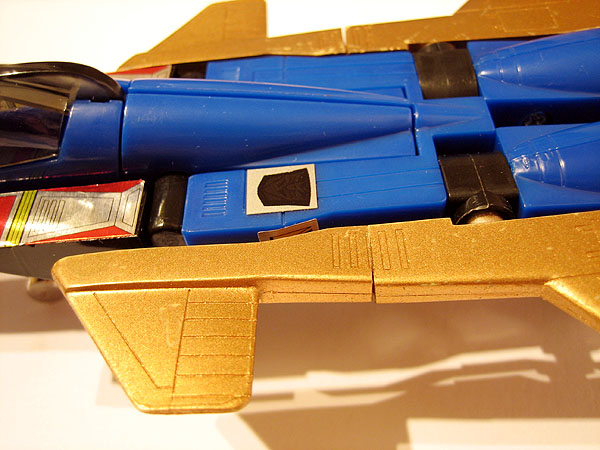
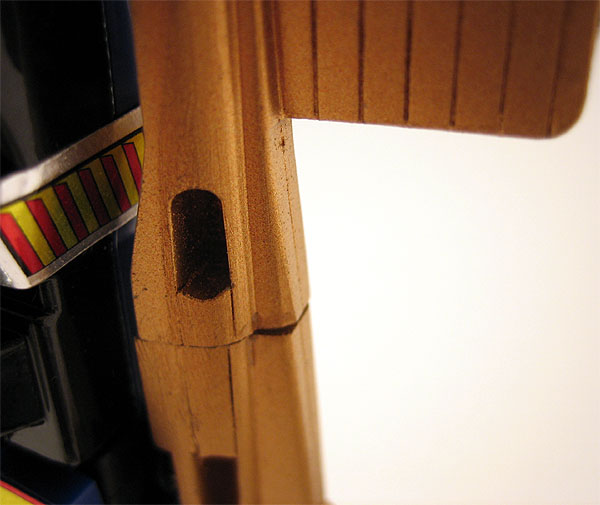
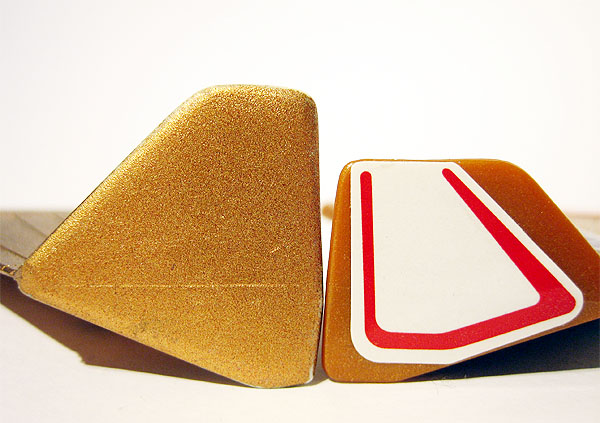
This last picture above highlights something very interesting indeed. The much larger vertical fin of the resin hardcopy prototype Dirge wing on the left appears to suit the factory sticker much better than the smaller production vertical fin on the right. We flipped the factory sticker around using a photo-editing package and when placed in the middle of the prototype vertical fin, appeared to be a much better match for the dimensions of the resin wing, much moreso than the slightly awkward fit of the sticker on the production wing. You can see my attempt at showing this below:
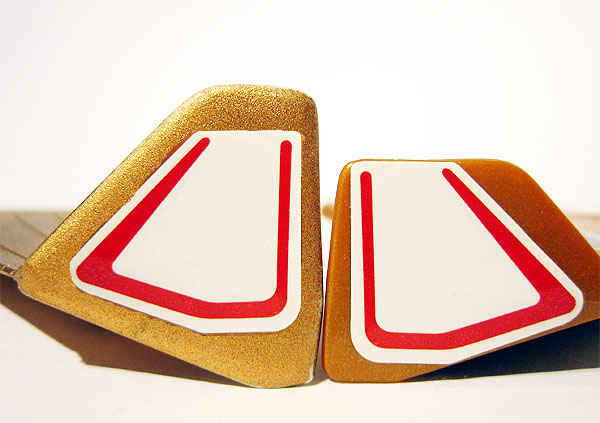
So maybe the Takara blue-winged Dirge mould is halfway between these two? Finally for Dirge, here are the larger prototype resin gold wings attached in robot mode:
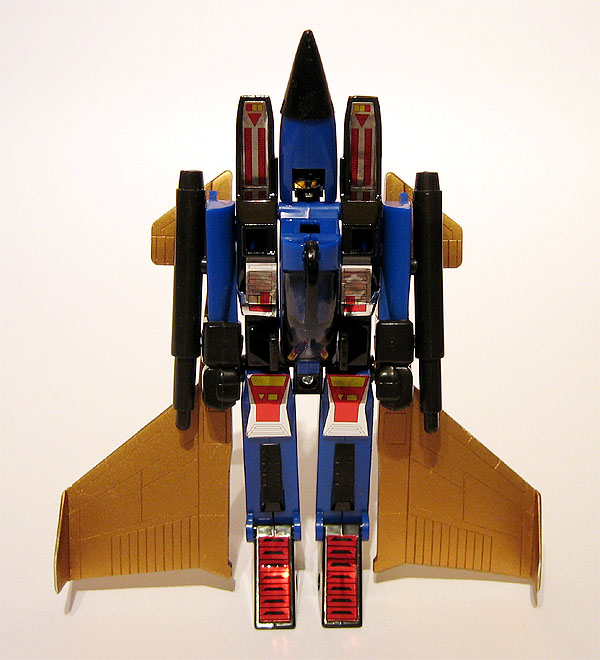
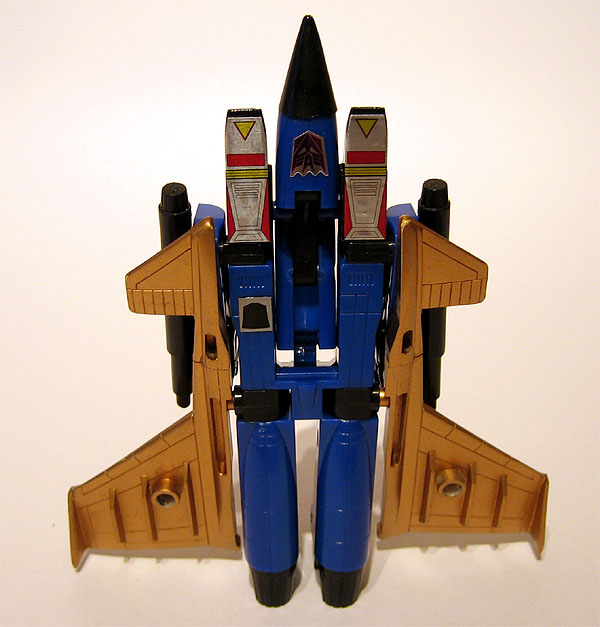
Can you see how much further up the robot body the smaller wings are? They are actually behind his shoulders, and that gives him a distinctly different appearance to the normal production Dirge. For comparison purposes, here is the Dirge robot mode again, but with one prototype wing and one production wing to illustrate just how different he does look with the hardcopy wings:
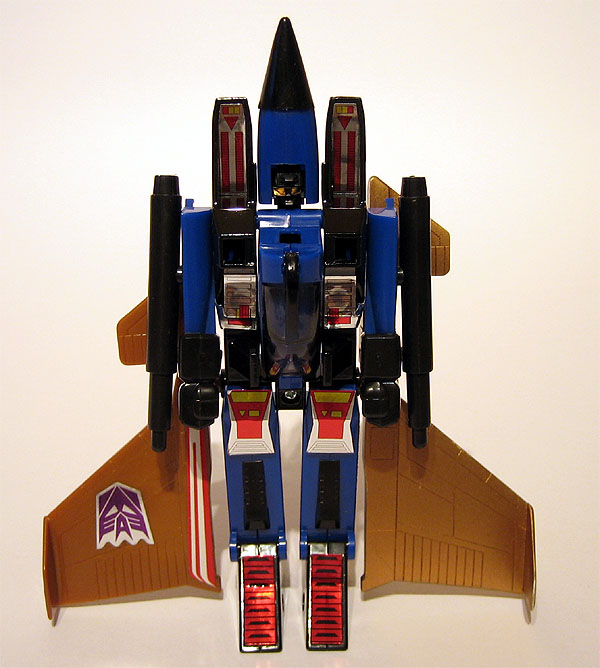
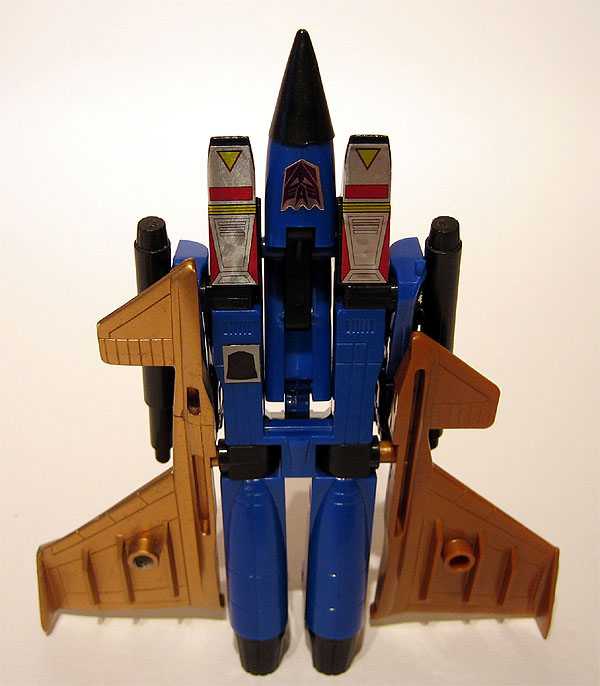
Let's now move on to a set of hand-painted resin hardcopy prototype Ramjet wings, which are a later stage in the evolutionary process than the unpainted hardcopy Ramjet wings with the one-piece fin and engine assembly. These painted hardcopy Ramjet wings didn't come with the engine or the fins for comparison.
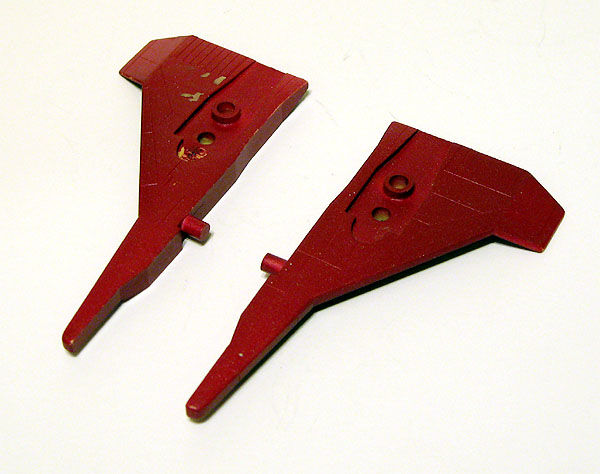
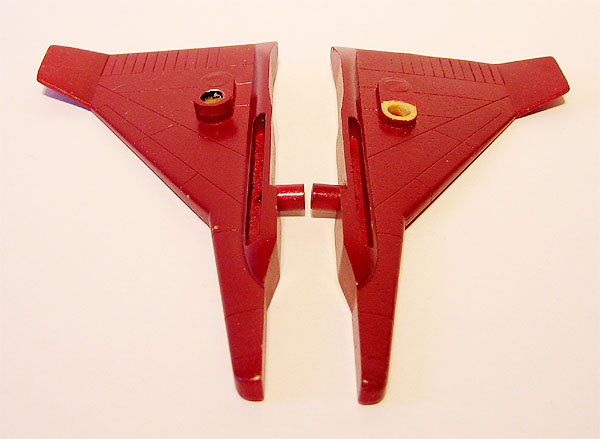
These hardcopy Ramjet wings, while not as spectacularly different as the Dirge wings, are clearly hand-painted. They are also slightly longer than the production Ramjet wings and a different shade of red. The hole for the cluster bomb on the right wing is broken (and is also a different mould to production), but it's not such a tragedy because you get to see the unpainted resin colour underneath. Here are a couple of close-ups that highlight the hand-painted nature of these wings very well:
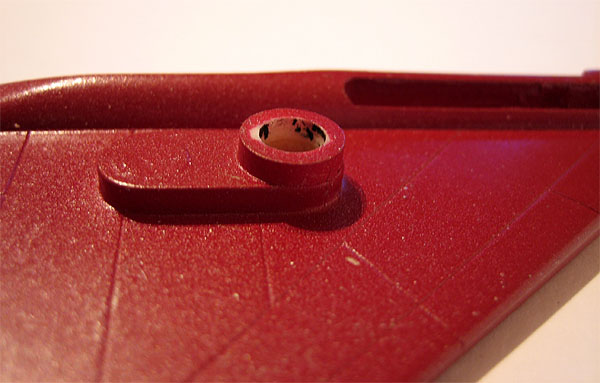
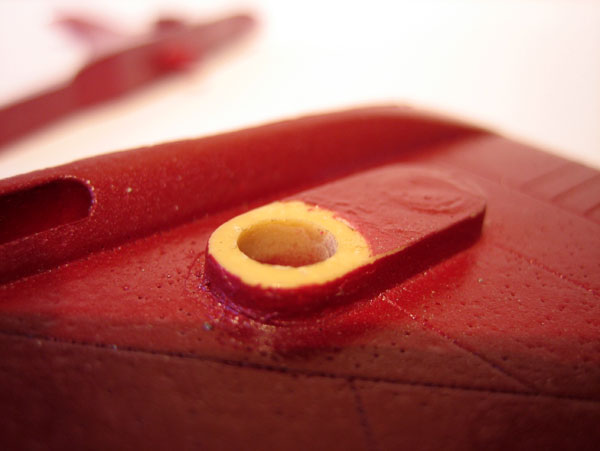
It's really something to know that you are looking at what was one of the very earliest physical manifestations of a concept that would become the Transformers Ramjet, the very pieces of resin that Hasbro/Takara used to make decisions on this toyline that we attach so much importance and affection to.
Here are the hardcopy Ramjet wings compared to production Ramjet wings:
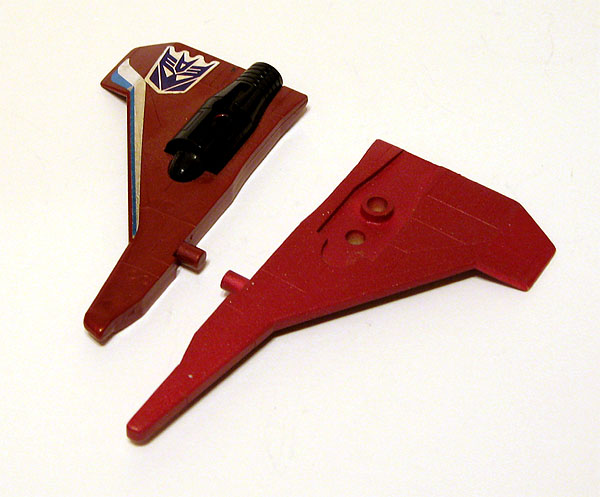
The above pictures show clearly the difference in size between the prototype and the production wings, as well as the colour difference. There are some slight moulding differences too, but nowhere near as many as the unpainted resin hardcopy wings which would have been much earlier than these painted versions.
Here is a production Ramjet with normal production wings attached:
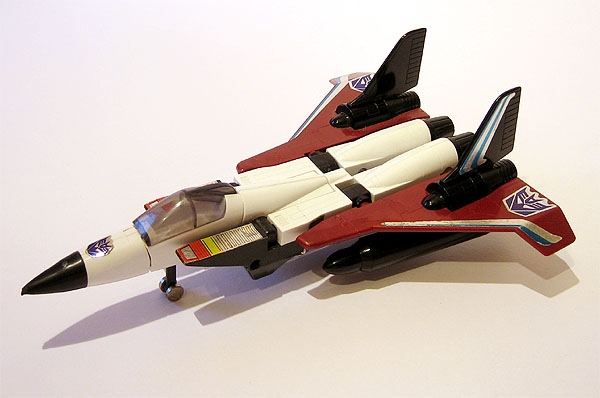
And here are some pictures of the same Ramjet but one of the production wings has been replaced with the hand-painted hardcopy prototype wing for comparison:
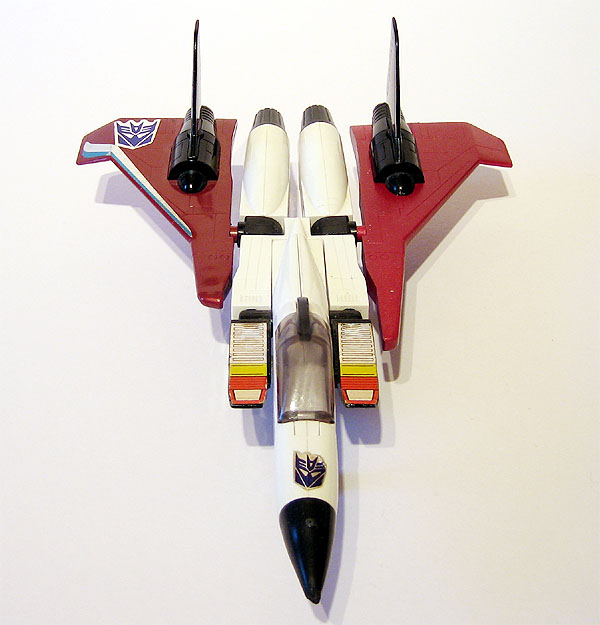
And here is Ramjet sporting both of the resin prototype wings, but the engines and vertical fins are production:
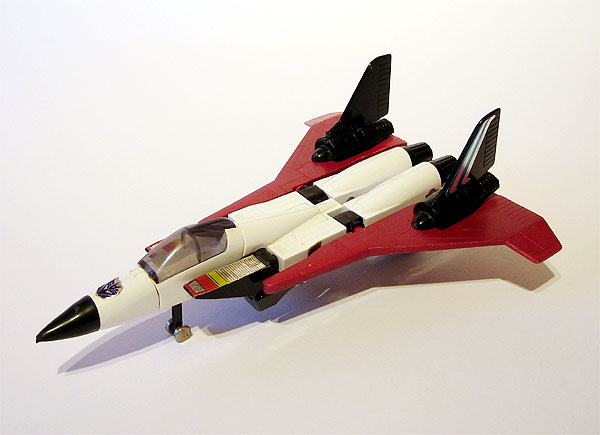
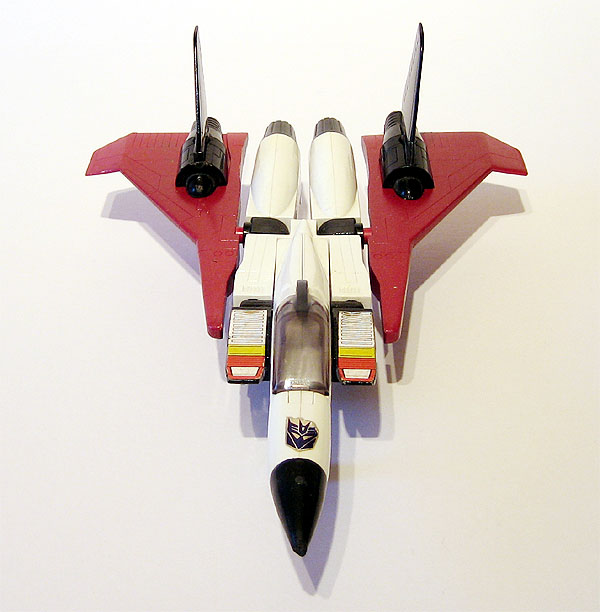
The longer wings give a slightly more elegant look to Ramjet as a whole in jet mode, and again I'm not sure if it's just the novelty value speaking here but I feel the lighter colour of the hardcopy wings suits the toy better. He also looks quite nice without the factory stripe decals on the wings.
Finally, here's Ramjet in robot mode sporting the hardcopy wings...
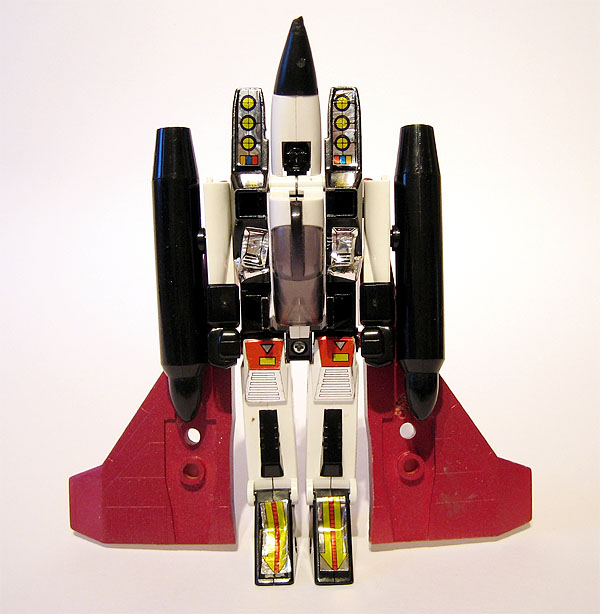
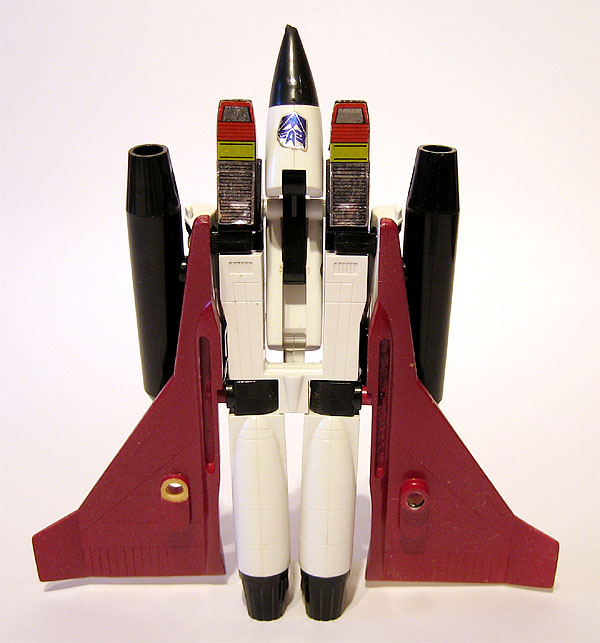
...and in robot mode sporting one prototype wing and one production wing for comparison:
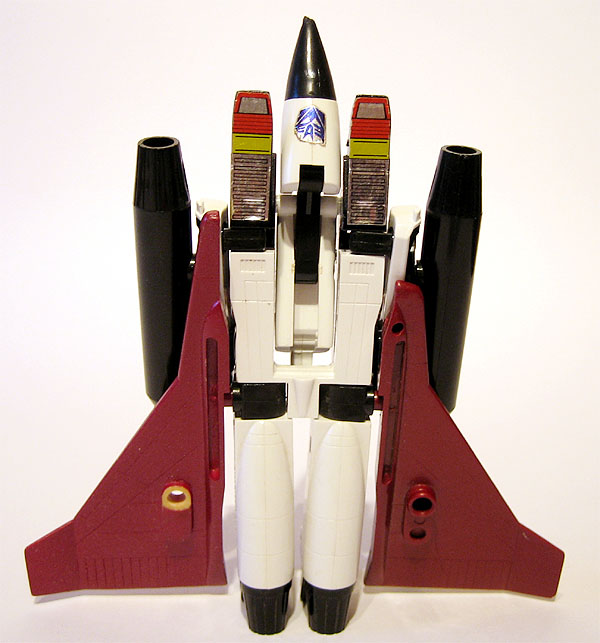
It is quite possible that these production wings were moulded shorter for Ramjet and Dirge because their original prototype size restricted the movement of the arms. This could be especially true in Dirge's case where the proto wings came all the way up to behind his shoulders.
Another thing that becomes apparent is that these prototypes were probably sculpted and moulded before the Takara catalog photo and artwork of the hybrid jets were produced. Even though those hybrid jets had production-mould shorter wings, they were the 'wrong' colour. So does that mean that these hardcopy prototype wings were painted AFTER the Takara literature was produced? Maybe Hasbro and Takara were working separately and the outcome was that Takara planned to take a different path to Hasbro with these jets, much like the case of the white Takara Astrotrain.
Whatever the case, the discovery of these prototype wings has been groundbreaking and another significant gap in the evolutionary process of these G1 Decepticon jets has been filled.
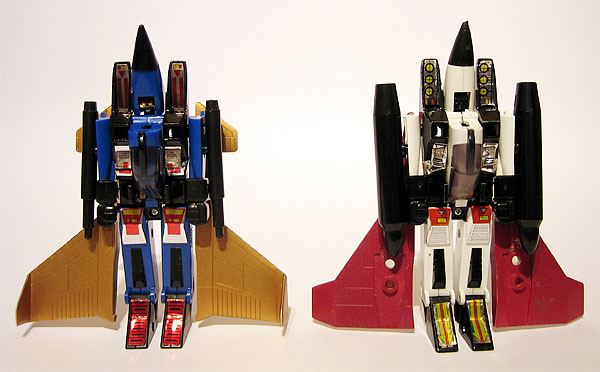
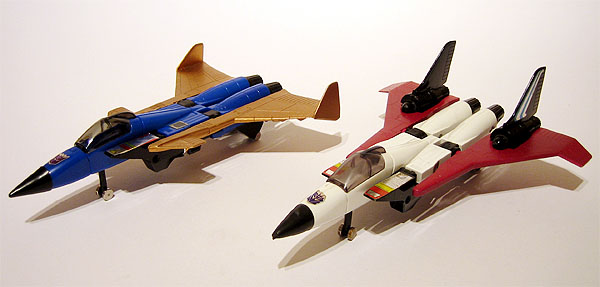
PART 3 : THE PRE-PRODUCTION ORANGE-CANOPIED RAMJET
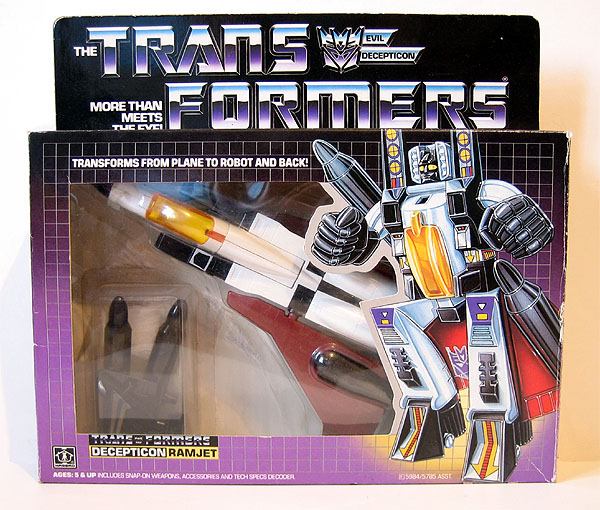
This final section of the article will focus on a very special version of the G1 Transformers Ramjet from the US. Our chronology has brought us to the point where the series 2 jets were being readied for mass release and most of the concepts and decisions about the toys had been made. This magnificent and historic Ramjet represents one of the final evolutions of the toy just previous to actual mass-release of the production versions.
So what is so special about the above Ramjet? Well, compare the above to a regular production US Ramjet seen here:
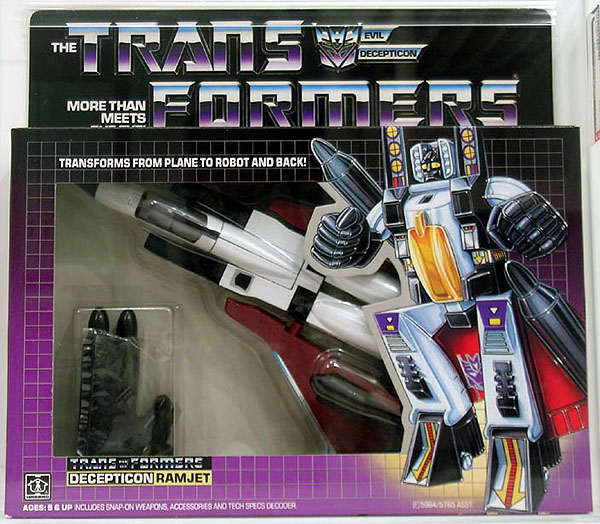
Here's the special Ramjet again, a little closer-in:
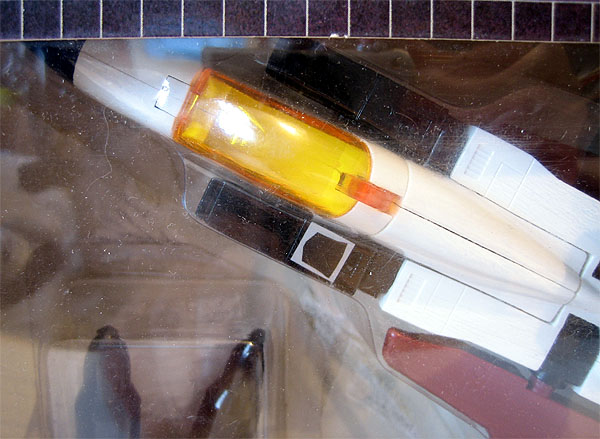
It's this section in the picture above that provides the most clues about the nature of this piece. First of all, the canopy of this Ramjet is orange. Even though Ramjet's boxart and box photography show him as having an orange canopy, when the production toy actually hit the stores he had a clear canopy. In very early catalogs he was shown with the orange canopy as well, but that was corrected very quickly as was the canopy on the toy itself. This Ramjet represents an extremely early version of the toy when these corrections had not yet taken place. Now, not only is the canopy orange, but it's an early pre-rub style smooth canopy! All production Ramjets would have come with a re-tooled ridged canopy.
Also, look at where the rubsign is. The fact that it's on the black diecast section means that when the stickersheet is applied to the toy, the rubsign would be covered up! That too would have been something corrected very quickly for release. Now think back to the early 1985 Takara photography showing those very strangely-coloured jets with the misplaced rubsigns and things slowly start to click into place.
There's more...
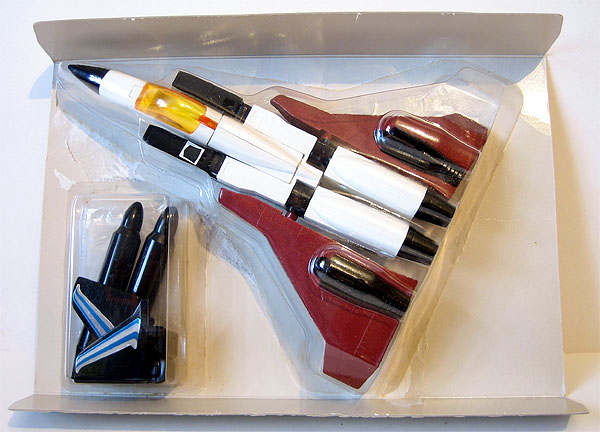
Apart from looking absolutely stunning in this condition (albeit a re-seal), there is something very important to note on the red wings. All production versions of Ramjet that were released throughout the world had those silver and blue striped factory stickers on the red wings, but this early pre-production orange-canopied Ramjet does not. Another clue as to how early this Ramjet is. The copyright is Takara + dates only showing yet again that it is an early Ramjet seeing as how a majority of rubsign-era series 2 Transformers would have had Hasbro stampings as well by this stage.
So how do we know this isn't just a custom job where someone has unsealed a Takara-stamping-only Ramjet, replaced the canopy, stripped off the factory stickers on the wings, re-placed the rubsign and then resealed it to sell as a variant? The answer to that lies in the history of the piece and where it came from. This particular Ramjet was sold on ebay in the summer of 2003 alongside many other pre-production pieces like production-sample Targetmasters and giftsets in hand-cut boxes, a Diaclone Grapple with "Sample" labels on and a Transformers Blitzwing with Diaclone factory stickers in a Diaclone box, obviously a packaging/marketing sample. You can see some of those on Curt's collection page here and the Grapple here
The person selling these items was an ex-Vice President of Hasbro in charge of the Boy's Toys division, responsible for product development on the Transformers toyline. He would approve each piece for final production, and keep an approved copy for himself. However, because they were not final production pieces, most showed some sort of variation from the final released versions. Pieces such as the orange-canopied Ramjet above were intended to be placed in a Hasbro Museum that would have showcased all the toys in the Transformers line. That project did not come to fruition and later these items were auctioned and sold off privately. This Ramjet was bought by the Hartman brothers on eBay, and I bought it from them at BotCon 2006. I remember the auction very well. In addition to this orange-canopied Ramjet, the seller had three other very curious series 2 jets for sale too:
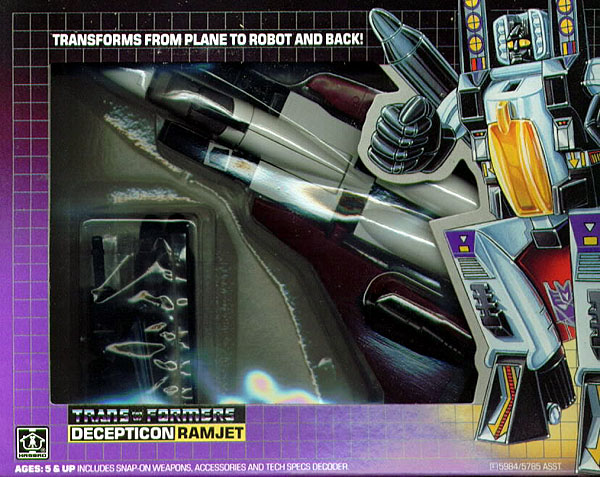
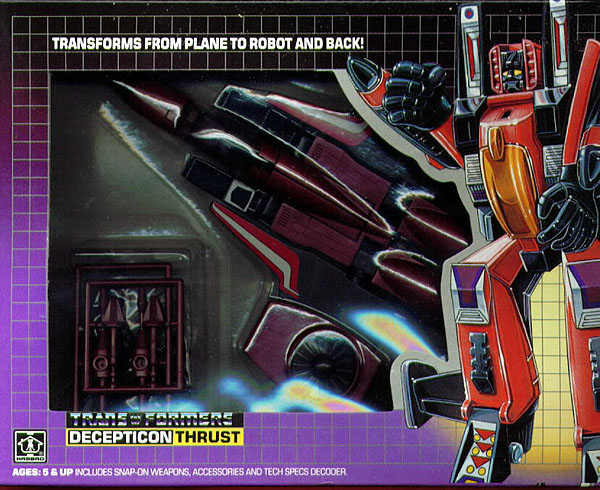
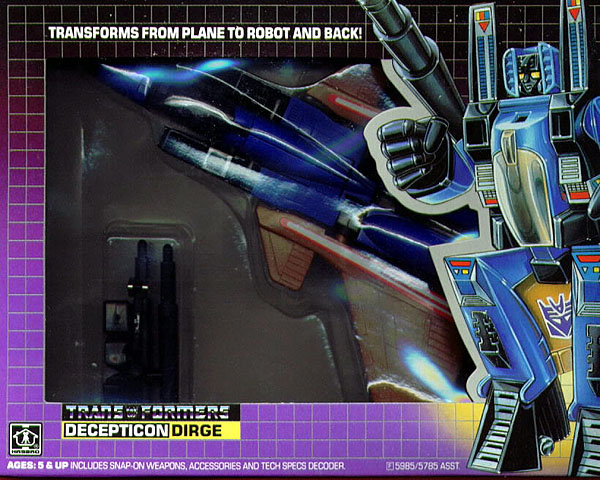
These three series 2 jets are of an extremely early design as well. Notice that all three again have the misplaced rubsign on the black diecast section! Thrust's red/white stripe factory stickers have a black line separating them and only the very earliest Thrusts show that variation. Notice also on Thrust's main wings, the maroon section, that horizontal moulding line I referred to with the letter 'E' earlier in the article, is not there. Thrust's artwork has an orange canopy, so maybe there is also an orange-canopied Thrust sample out there somewhere as well. If you look closely at Ramjet, you can see that although he has the correct production clear and ridged canopy, the red wings STILL have no factory stickers on them. I am doubtful that these three jets were ever available on a store shelf, so maybe they are just the next production sample stage after the orange-canopied Ramjet, some alterations made, but not yet fully production versions.
Going back to the orange-canopied Ramjet, here are some more detailed pictures of the packaging:

On all US Transformers Ramjet packaging in the US, Ramjet is shown as having a smooth orange canopy just like in the pre-production toy pictured in this article. Not only that, but the fists are the earlier versions without the "U" tab on the inside, much like the early pre-rub Thundercracker's fists. The keen-eyed amongst you will also notice that the red wings on the box photography seem to be of a slightly different mould to the production wings too, somewhere in-between the painted hardcopy prototype and the production wings. The wings depicted on the box photography don't appear to have those aforementioned circles moulded into the wings near the tip, and speaking of the tip it looks a little more pointy than the production version.
Also, have you ever noticed how Ramjet's boxart shows him with purple knee stickers, as does the box photography (although they look hand-painted) yet the toy always came with red knee stickers?
Here is the paperwork baggie that came with the production-sample orange-canopied Ramjet:
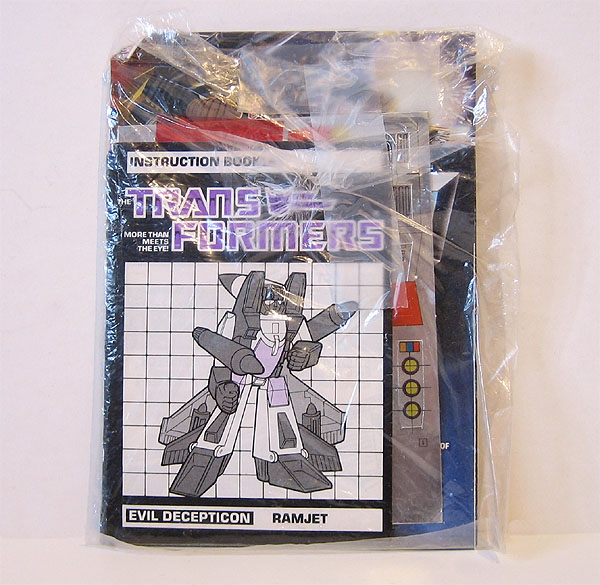
You can see the knee stickers on the stickersheet are red, like the subsequent production Ramjets would have had. Also keep in mind that the Takara catalog photography and artwork for those strange hybrid jets also showed their "Ramjet" with red knee stickers. So the Ramjet featured on the US Transformers boxes was probably earlier than the Takara hybrids and earlier than the orange-canopied sample in this article as it appears to feature hand-painted purple knee stickers and more pre-rub parts than the packaged sample. It was probably very close behind the test shots Hasbro were using with the painted hardcopy resin wings featured in this article.
A little further down the line, these toys were of course available in mainland Europe where early catalogs show some even stranger possible concepts for the series 2 jets:
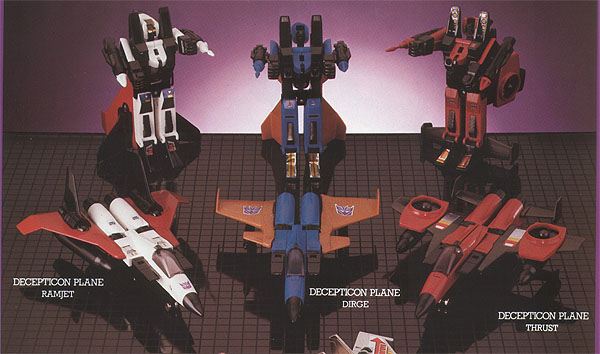
In the above picture (featured in the MB article as well), none of the jets have factory stickers or rubsigns at all, they have misplaced stickersheet decals and mixed-up accessories. Nothing amazing there, just some confusion. But look at Ramjet...series 1 style WHITE long and short missles and purple knee stickers! Dirge also appears to have series 1-style weapons and all three jets have SMOOTH clear canopies. This evidence makes the chronology of these pieces a little difficult to determine. Correctly-coloured canopies would place it after the time of the orange-canopied Ramjet sample, but the purple knee stickers on Ramjet and the series-1 style weapons place it before. It is never going to be simple to sort out an exact chronology for these things because many concepts could have been entertained simultaneously with some things being carried over or re-visited, and this can be evidenced by the fact that in the above picture the production-style Ramjet bombs are shown too albeit with Thrust. From a distance it would appear that this catalog is from roughly the same kind of time as the production sample series 2 jets.
All of the points covered in this article hopefully have given you some insight into how differently things could have turned out for the jets that are so familiar to us in their production guises. In some cases it would have been relatively minor differences such as canopy colour or sticker colour or slightly longer wings, yet in some cases it could have been major differences like actual style of weapons, much larger different-mould wings and the colour of the jet itself! It all gives a fascinating glimpse into the evolutionary process undertaken by these toys before they became what we know and recognise today and even back in the 80s.
I'll leave you with a couple of pictures of what could, and might have been...
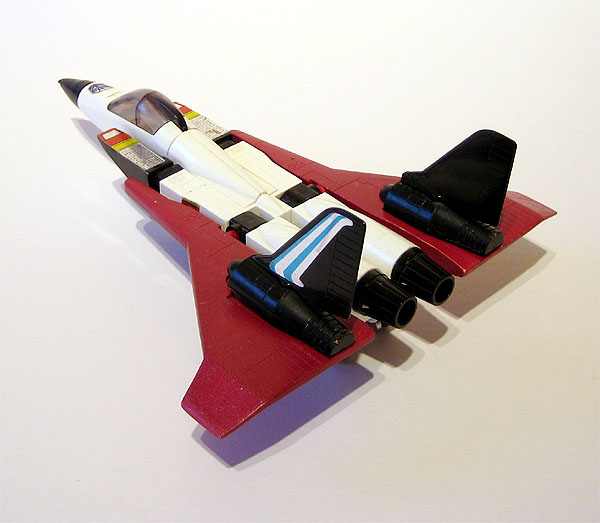
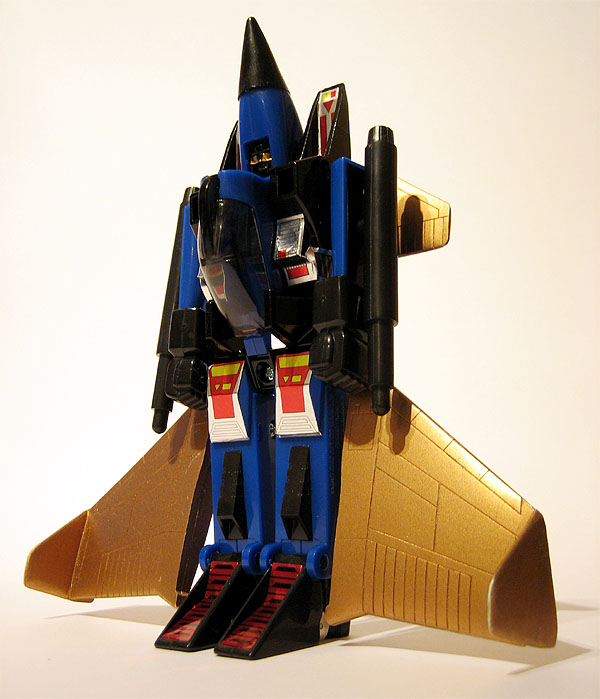
Many many kind contributions have been made during the course of this article, and without those contributions none of this would have been possible, so my deepest gratitude must go to the following people:
Paul Hitchens for unlimited access to his magnificent painted hardcopy prototype Dirge and Ramjet wings and use of his pictures, Takara catalog and literature images, Japanese Television Magazine scans, US 1985 product assortment code sheet scan and MB catalog scan.
Himawari for unlimited access to photographs of his phenomenal collection, his photographs and information on the sealed early pre-rub Thundercracker, translations and ongoing feedback and insight.
Curt Fignar for the invaluable information regarding the pre-production items destined for the Hasbro museum, translations and his insight on the early-pre rub packaging.
Anonymous credit must go to the provider of the unpainted hardcopy resin Thrust, Dirge and Ramjet wing images, you know who you are.
Ben Munn for the MISB G1 Starscream, Sunstreaker and Mirage images and unlimited access to his collection pictures.
Cloud City Collectibles for the use of their MISB US Ramjet picture.
Jon and Karl Hartman for being an immense part of the fandom, an absolute pleasure to meet, talk to and for the orange-canopied Ramjet.
All the best
Maz
